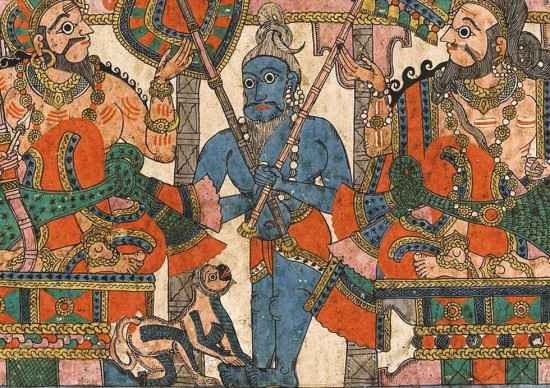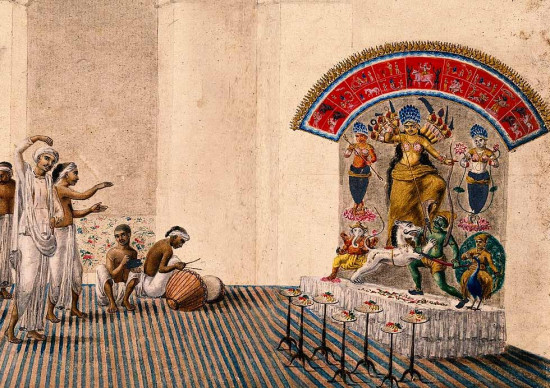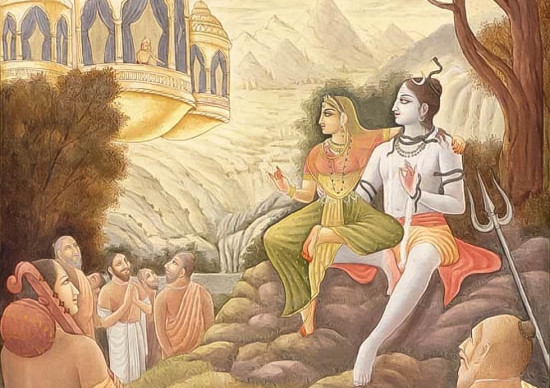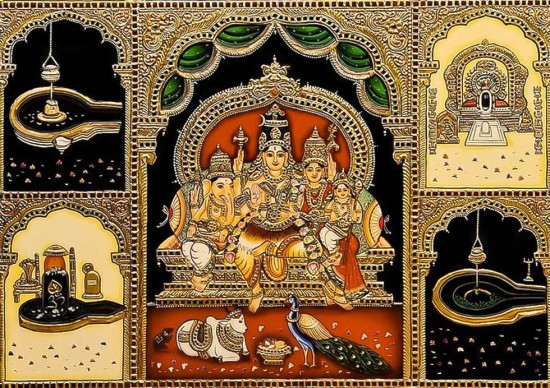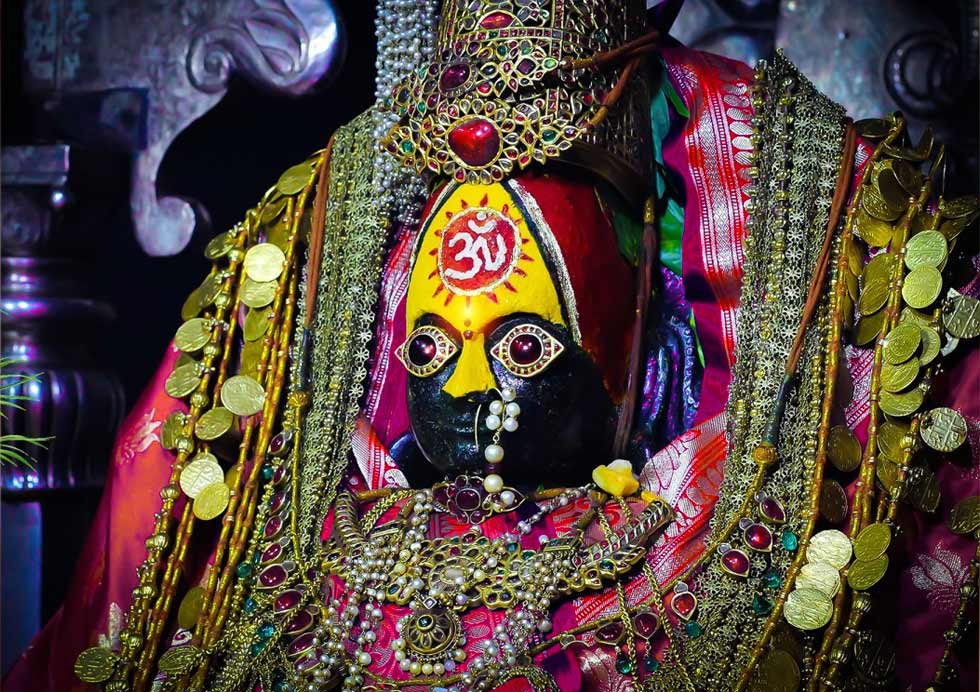
Nestled in the heart of Maharashtra, the Shree Tulja Bhavani Temple stands as a beacon of faith and devotion, drawing countless devotees to its sacred grounds. Revered as a Shakti Peetha, this temple is not merely a place of worship; it embodies a rich historical legacy intertwined with the cultural fabric of India. Shree Tulja Bhavani Temple is dedicated to Goddess Tulja Bhavani. It is situated in Tuljapur, within the Dharashiv district of Maharashtra, India, and is recognized as one of the 51 Shakti Peethas. The temple is located about 45 km from Solapur. Built in the 12th century CE, it was established by Maratha Mahamandaleshwar Māradadeva of the Kadamba dynasty.
The Tulja Bhavani Temple has played a significant role in the Maratha Empire, symbolizing the pride and courage of the Maratha people. The shrine is closely associated with the illustrious Bhonsla dynasty, who were devoted followers of Goddess Tulja Bhavani. It is said that the Bhonsles visited the temple regularly, making heartfelt offerings to the Shree Tulja Bhavani Mata. Additionally, the temple served as a vital center for the Bhakti movement, a spiritual and social reform initiative that began in Maharashtra in the 13th century.
The Tulja Bhavani Temple has played a significant role in the Maratha Empire, symbolizing the pride and courage of the Maratha people. The shrine is closely associated with the illustrious Bhonsla dynasty, who were devoted followers of Goddess Tulja Bhavani. It is said that the Bhonsles visited the temple regularly, making heartfelt offerings to the Shree Tulja Bhavani Mata. Additionally, the temple served as a vital center for the Bhakti movement, a spiritual and social reform initiative that began in Maharashtra in the 13th century.

Shree Tulja Bhavani
Shree Tulja Bhavani is the goddess of power and justice. Also known as Bhowanee, Tulaja, Turaja, Tvarita, Ambā, and Jagadambā, she is an incarnation of the devi Parvati. Worshiped mainly in Maharashtra, she is also revered by the Rajputs in North Gujarat, Northern Karnataka, Western Rajasthan, and Punjab.
The name Bhavani means "giver of life," symbolizing the power of nature and the source of creative energy. She is seen as a mother who cares for her devotees and plays an important role in delivering justice by defeating evil forces (Asuras).
Shree Tulja Bhavani is considered a form of Durga and is especially honored in Maharashtra. Shivaji, the great Maratha king and a brave warrior, was a devoted follower of Goddess Tulja Amba Bhavani.
Iconography of Shree Tulja Bhavani
Tulja Bhavani is depicted as a standing goddess with 8 arms, often holding weapons like a sword and trident. She has a calm yet strong expression, with large, expressive eyes. Dressed in traditional Indian attire, she is adorned with beautiful jewelry such as necklaces and earrings, enhancing her divine status. Accompanying her is often a lion or tiger.
The Tulja Bhavani murti in the Shree Tulja Bhavani Temple is crafted from black stone, featuring her in a powerful stance, and is revered for its spiritual energy. Devotees offer flowers, fruits, and prayers in front of her idol, connecting with her presence during worship.
The Tulja Bhavani murti in the Shree Tulja Bhavani Temple is crafted from black stone, featuring her in a powerful stance, and is revered for its spiritual energy. Devotees offer flowers, fruits, and prayers in front of her idol, connecting with her presence during worship.
History of Tulja Bhavani Temple
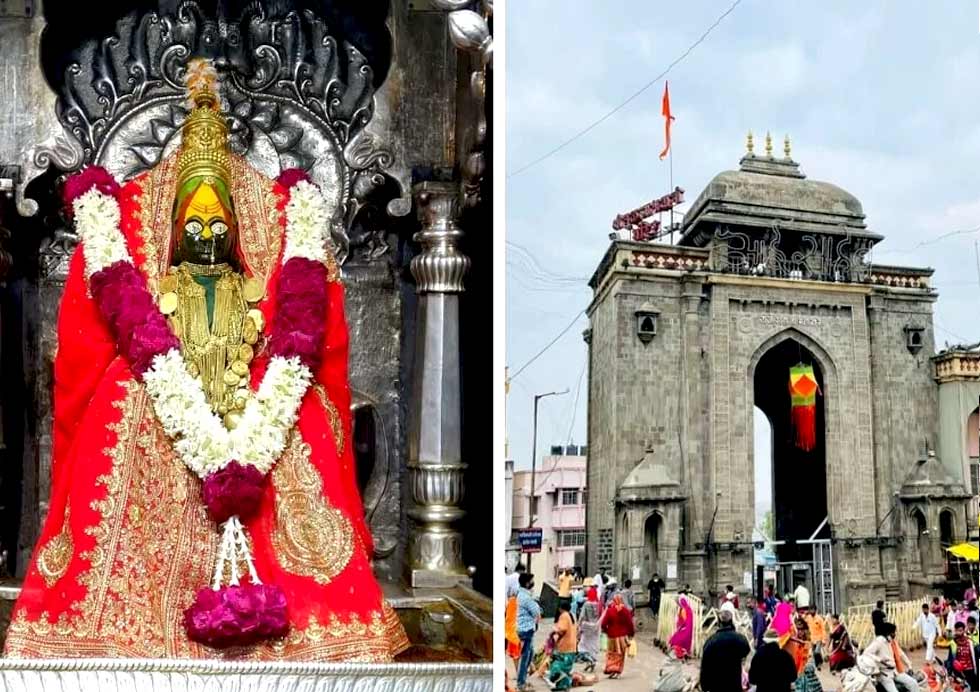
In the Sri Skanda Purana, the story of the goddess's avatar unfolds beautifully. After the passing of Sage Kardam during Krita Yuga, his devoted wife Anubhuti sought to reunite with him. However, considering her young son, the other sages persuaded her to abandon this desire. In her sorrow, Anubhuti chose to engage in deep penance by the banks of the Mandakini river.
During this time, a demon named Kukar attempted to disrupt her devotion and chastity. In her moment of distress, Anubhuti called out to Shri Bhagwati for help. Responding to her plea, Shri Bhagwati incarnated to vanquish the wicked demon. At Anubhuti's request, the goddess chose to reside forever on the sacred mountain Yamunachal (Bala Ghat).
During this time, a demon named Kukar attempted to disrupt her devotion and chastity. In her moment of distress, Anubhuti called out to Shri Bhagwati for help. Responding to her plea, Shri Bhagwati incarnated to vanquish the wicked demon. At Anubhuti's request, the goddess chose to reside forever on the sacred mountain Yamunachal (Bala Ghat).
In India, there are three revered places of the Triguna Adisakti:
1. Mahakali in Calcutta, embodying Tamoguna,
2. Shree Mahalakshmi in Kolhapur, representing Rajoguna,
3. Mahasaraswati in Mahur, celebrated for Sattva.
Shri Tulja Bhavani is regarded as the embodiment of all three Gunas, serving as the foundation of their divine energies.
When Prabhu Sri Ramchandra was in exile, searching for his beloved Sita, Sri Bhagwati graciously revealed herself to him, assuring him that he would soon be reunited with Sita.
One another story about Goddess Tulja Bhavani tells of a powerful demon named Madhu-Kaitabh, who was causing trouble for both the gods and humans. In their time of need, the gods turned to Lord Brahma for help. He advised them to seek the strength of Goddess Shakti. Responding to their calls, the Goddess took on a fierce form, and with the help of the seven divine mothers—Brahmi, Vaishnavi, Kaumaari, Indraani, and Saambhavi—she defeated the demon and brought peace back to the world.
Another story tells how Bhavani faced a demon who had disguised himself as a buffalo (Mahisha) and took shelter on Yamunachala Hill in the Balaghat mountain range. It is on this sacred hill that the Shree Tulja Bhavani Temple stands today, a symbol of the goddess’s power and kindness. Here, devotees come together to honor Tulja Amba Bhavani, celebrating her victories and seeking her blessings, always thankful for her protection.
When Prabhu Sri Ramchandra was in exile, searching for his beloved Sita, Sri Bhagwati graciously revealed herself to him, assuring him that he would soon be reunited with Sita.
One another story about Goddess Tulja Bhavani tells of a powerful demon named Madhu-Kaitabh, who was causing trouble for both the gods and humans. In their time of need, the gods turned to Lord Brahma for help. He advised them to seek the strength of Goddess Shakti. Responding to their calls, the Goddess took on a fierce form, and with the help of the seven divine mothers—Brahmi, Vaishnavi, Kaumaari, Indraani, and Saambhavi—she defeated the demon and brought peace back to the world.
Another story tells how Bhavani faced a demon who had disguised himself as a buffalo (Mahisha) and took shelter on Yamunachala Hill in the Balaghat mountain range. It is on this sacred hill that the Shree Tulja Bhavani Temple stands today, a symbol of the goddess’s power and kindness. Here, devotees come together to honor Tulja Amba Bhavani, celebrating her victories and seeking her blessings, always thankful for her protection.
Architectural Splendor of Shree Tulja Bhavani Temple
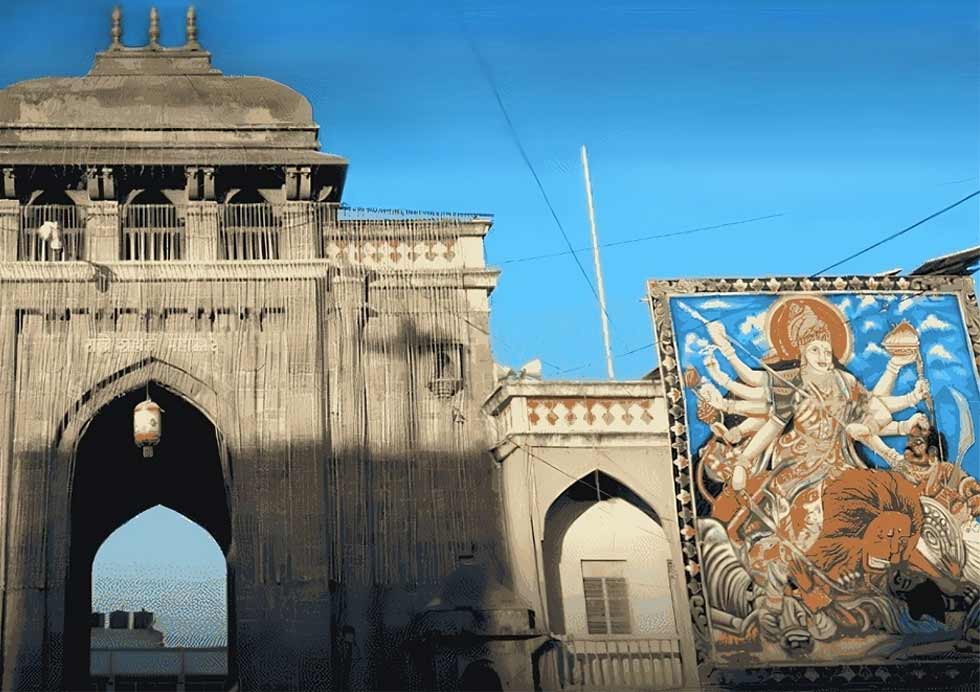
The Shree Tulja Bhavani Temple is an architectural marvel, drawing visitors not only for its spiritual significance but also for its artistic beauty. The temple complex, adorned with intricate carvings and sculptures, is a feast for the eyes. The primary sanctum houses the Tulja Bhavani idol, a majestic idol that inspires profound reverence.
The temple’s architecture reflects a blend of different styles, showcasing the influence of various dynasties that ruled over the region. Each carving and design element serves as a reminder of the craftsmanship and devotion that went into its creation. The Tulja Bhavani painting that adorns the temple walls depicts various legends associated with the goddess, immersing visitors in the rich tapestry of her stories.
The temple’s architecture reflects a blend of different styles, showcasing the influence of various dynasties that ruled over the region. Each carving and design element serves as a reminder of the craftsmanship and devotion that went into its creation. The Tulja Bhavani painting that adorns the temple walls depicts various legends associated with the goddess, immersing visitors in the rich tapestry of her stories.
Cultural Significance of Shree Tulja Bhavani Temple
The Shree Tulja Bhavani Temple is not just a religious site; it is a cultural hub that plays a vital role in the local community. Festivals celebrated here, such as Navratri and Diwali, draw thousands of pilgrims, uniting people in a shared expression of faith. These festivities are marked by vibrant processions, music, dance, and rituals that celebrate the divine feminine energy of Tulja Bhavani.
The temple also serves as a center for various spiritual activities, including meditation and yoga, attracting seekers from all walks of life. It fosters a sense of community among devotees, encouraging them to come together in worship and service.
Shree Tulja Bhavani Temple is not just a sacred site; it is a living embodiment of faith, devotion, and history. As devotees gather to honor Goddess Tulja Bhavani, they are reminded of her unwavering protection and boundless love. The rich stories, vibrant festivals, and the serene presence of the goddess inspire countless individuals to seek her blessings and strength in their lives. This temple, with its magnificent architecture and deep cultural significance, serves as a beacon of hope and spiritual nourishment for all who visit. In every prayer offered and every heart that seeks her grace, Tulja Amba Bhavani continues to illuminate the path of her devotees, guiding them through life's challenges with compassion and power. May her divine blessings always be with us, nurturing our spirits and leading us toward justice, strength, and peace.
Shree Tulja Bhavani Temple is not just a sacred site; it is a living embodiment of faith, devotion, and history. As devotees gather to honor Goddess Tulja Bhavani, they are reminded of her unwavering protection and boundless love. The rich stories, vibrant festivals, and the serene presence of the goddess inspire countless individuals to seek her blessings and strength in their lives. This temple, with its magnificent architecture and deep cultural significance, serves as a beacon of hope and spiritual nourishment for all who visit. In every prayer offered and every heart that seeks her grace, Tulja Amba Bhavani continues to illuminate the path of her devotees, guiding them through life's challenges with compassion and power. May her divine blessings always be with us, nurturing our spirits and leading us toward justice, strength, and peace.

